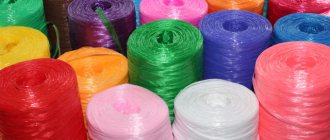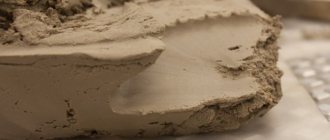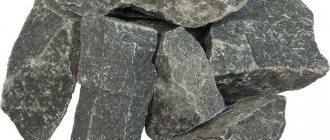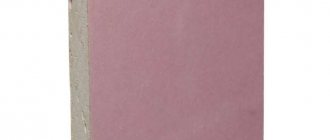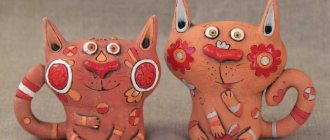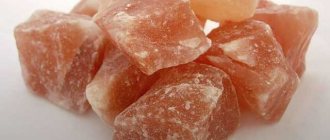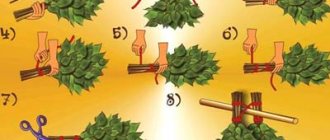I was sure that I had never used or washed a natural bast washcloth. Imagine my surprise when my mother dispelled my beliefs. It was with a bast washcloth that I was washed as a child; this shapeless tow was used for washing in our black bathhouse...
A disheveled bunch of an incomprehensible light brown color, spreading in different directions - this is a real bast washcloth!
In ancient times, people did not stand on ceremony with bath accessories. We didn’t choose everything in the same color scheme, we didn’t choose gentle washcloths, we didn’t look for fragrant soft soap, the shampoos were the simplest.
What is bast
Bast is the inner fibrous side of the linden bark, that is, its fragile subcortical part.
The top layer of linden bark is peeled off and the resulting thin light material is cut into thin strips, from which a natural bath attribute is obtained.
But not only linden bast is used to make washcloths. You can use the bast of any young deciduous tree for the loofah.
Dry massage brush
It can not only replace the usual washcloth, but also significantly improve the quality of the skin. Some people use a brush for self-massage in the shower, others without using water.
If we talk specifically about replacing a washcloth with this brush, then there is a simple ritual:
- Steam your body under hot water
- Apply soap or gel to the body
- Use the brush on each leg first. From bottom to top, applying a little force, but without causing discomfort to the skin. Especially “work out” the hips and buttocks. This improves blood circulation and removes excess fluid from the body. Some people even manage to get rid of cellulite this way.
- Then move on to your hands. Also from the hands to the shoulders, from bottom to top.
You can and should use a brush for self-massage constantly, two to four times a week. It costs approximately 1,000 rubles. It is made from different materials, but it is better to buy one with natural bristles and a wooden handle.
When is the best time to harvest bast?
It is best to prepare the future washcloth from bast in the spring. At this time, the tree is gaining spring sap, its bark is tender and soft. But when it dries, it coarsens, becomes hard and tough.
Therefore, when the bast is cut, it is soaked in water to make it more soft and flexible.
Then the strips are collected into a bundle, which can be tied - this is how you get a washcloth. Agree, everything is quite simple...
The benefits of a washcloth for the body
The new washcloth made from natural fibers itself is very useful. Massaging movements help blood circulation, improve metabolism and a host of other benefits. Of course, it also fulfills its direct purpose – ridding the body of dirt – with a bang.
Thanks to the washcloth, it’s easy to whip soap or shower gel into foam, which also makes water procedures more enjoyable than smearing the detergent all over yourself with your hand.
It's easier to reach the back with a washcloth. There are products with two handles. And you won’t have to ask anyone to rub your back. Unless, of course, you yourself want to.
The washcloth acts as a sponge for washing dishes. The effect is the same. The skin is steamed under hot water and a washcloth, as if wiping the body from dust and sweat. You just smear it with your hand.
Where is bast used?
Bast is not just washcloths. From time immemorial, bast was used to weave bast shoes, household utensils, baskets, boxes, and so on...
Lyko became so firmly established in the lives of Russian peasants that it would be difficult to imagine their life without him.
There are quite a lot of proverbs and sayings associated with bast. For example, our everyday saying: “The bast does not knit.” This means that a person is drunk to such an extent that he cannot cope with an ordinary, simple task.
Shoes and household items made from bast were considered a sign of the poor and of simple origin. When they said about a person: “Girded with bast” or “Woe is bast” - this meant that the person lived in poverty.
The bast washcloth is one of the oldest. These are the types of washcloths that have replaced “disposable cleaning agents.”
Nettle washcloth
And other natural plants - this is splendor in the flesh. Previously, we only washed ourselves with nettle washcloths. It's easy to do. Tear a bunch and pour boiling water over it. It won’t hurt so much, and your body will receive such a charge of usefulness that you can only dream of. If you have your own bathhouse, then God himself ordered to wash with just such washcloths.
Nettles can be dried (like brooms) and a natural washcloth can be used all year round. It will be disposable - you wash it and throw it away, but the difference from a store-bought one is colossal.
And if you know how to knit, then be sure to crochet a washcloth . This link contains many patterns for beginners and advanced needlewomen.
About disposable washcloths
Initially, the role of a washcloth in a bathhouse was performed by a bunch of straw or ordinary grass. Grass or hay was collected in a bunch, doused with warm water to wash away possible contamination, and the simplest bath attribute is ready for cleansing procedures!
Everything would be fine: the herbs are good for the skin, and the hay smells like summer. Disposable washcloths are individual, they are not capable of transmitting infections and diseases to other visitors to the bathing kingdom.
But such washcloths do not have reliability, rigidity, or long service life. So the bast soap came to the rescue, it rubbed conscientiously and lasted much longer than disposable washcloths.
The best ideas on how to make a washcloth with your own hands
Crocheting or knitting a washcloth is a fun and fairly quick process. However, if you are a beginner craftswoman, choose simple models and patterns for your first craft, for example, a round sponge for washing dishes. As your knitting experience grows, you can move on to creating bath sponges with elongated loops and long handles, as well as massage devices in the form of mittens. Separately, it should be said about creating products from birch bark; if you have all the necessary materials, then making a sponge is not difficult, even without the use of special tools.
Yarn dishwasher
An ideal option for beginner knitters is to create a dishwashing product. It is very easy to make a washcloth step by step: cast on a sufficient number of loops on the hook, knit several single crochets and close the row. If you have a little more time, you can make a multi-colored dish sponge using leftover yarn you have at home.
Necessary materials:
- synthetic fibers - choose colors as desired;
- hook.
How to make a washcloth for washing dishes:
- We put 21 air loops on the hook.
- In the second loop from the hook we make two single crochets, and then one single crochet in each loop.
- On the last loops of the row we make a decrease: on the hook we pull two loops from adjacent chain stitches of the base, stretch the cast-on loops together without a crochet.
- In the second row, we again make a decrease at the beginning (we knit two loops together), and at the end of the row we make an extension.
- Every two rows we change the color of the knitting if you want to make the washcloth multi-colored.
- When there is enough knitting to form a ring, sew the two edges together. You can sew a washcloth with hooks.
The finished product produces a dense rectangular washcloth, already suitable for use in the kitchen. But you can also tighten the free edges so that the craft takes on a neat round shape.
Note! It’s even easier to make such a washcloth with knitting needles, especially if you prefer to use natural fibers for your work. Decreasing and adding loops is carried out at the edges of the row, and the product is sewn together with a regular needle or crochet hook.
Polypropylene fiber shower sponge
Oblong knitted washcloths with long handles are an ideal bath option. If you make the product yourself, you can control the size and stiffness of the knitting. For work, it is better to use polypropylene fiber, and to make the sponge lather better, choose a knit with elongated loops. For extra fluffy foam, you can also put foam rubber inside the knitting.
Necessary materials:
- polypropylene fiber - 1 skein;
- hook of the appropriate size.
How to make a washcloth with elongated loops:
- We put 56 chain loops on the hook (if you want to make the washcloth wider, increase their number so that you get an even number). We close the air loops into a ring.
- Using single crochets we go through 5 rows.
- In the sixth row we knit loops; to do this, before fixing the loop, we yarn over the fiber onto the thumb.
- We knit the next two rows with a regular single crochet.
- We repeat the pattern with loops and single crochet until we get a washcloth of sufficient size.
- We finish the product with five single crochets.
- The handle consists of 4 rows of single crochets. Select the number of air loops individually depending on the length of the handles you want to get.
To make the elongated loops the same, beginners will have to try. It is quite difficult to always keep the yarn over evenly. Therefore, for the first crafts, it is recommended to use a cardboard template: instead of a finger, place an elongated loop on a cardboard strip. The wider the paper strip, the longer the loop will be.
If you decide to knit such a washcloth with your own hands using knitting needles, then use the “Front stitch” pattern for knitting. To get an elongated loop, just make a few yarn overs on your index finger, and then secure the knitting with a knit stitch.
Sponge-mitten for massage and peeling made of jute
For home peeling, it is most convenient to use bath accessories in the form of a mitten. This will simplify and speed up the healing procedure. If you make such a mitten yourself, you can make one side softer - with elongated loops, and the other harder - from a tight knit. A combination of different textures will allow you to best treat your skin. For high-quality hygiene, jute washcloths are suitable.
Necessary materials:
- jute - 1 skein;
- hook No. 6 (you can use a thinner hook, but for beginners the work will be more difficult).
How to make a massage washcloth in the form of a mitten:
- We put a chain of 30 air loops on the hook. If the chain connected into a ring does not fit on your hand, the number of loops must be increased.
- We connect a chain of air loops into a ring.
- We knit two rows with double crochets.
- We knit the third row as follows: in the first half we alternate an elongated loop with a regular single crochet, we knit the second half of the mitten with single crochets, inserting the hook only behind the back wall of the base loop (the pattern should be ribbed).
- We knit 4-5 rows up to the thumb (the number of rows depends on the size of your hand).
- To make a hole for the thumb, we make 8 air loops and through 8 loops on the base we knit a single crochet. Next, we continue to knit the mitten according to the pattern.
- When the knitting reaches the nail plate of the little finger, we begin to reduce the number of loops. Deductions are made every 3 stitches according to the following principle: we knit 3 loops according to the pattern, and knit the fourth and fifth stitches together.
- When the top of the mitten is narrow enough, close the knitting, hiding the rest of the thread inside the mitten.
- The thumb can be left untied, leaving the slit open. But if you want to completely knit the product, then use 16 free loops in the slot. The thumb can also be knitted in a double-sided pattern.
If this jute washcloth seems too complicated for you, try knitting a classic ring that can be fixed exclusively on four fingers. Massage using such a craft will require more time, but will not reduce the effectiveness of the procedure.
Properties of bast sponge
Any natural washcloths are hard! They do an excellent job of deep cleaning pores. The phytoncides for which linden bast is famous kill all microbes that it encounters on the skin!
The bast sponge has an excellent scrub effect that lasts until the last days of its service, but there are also some inconveniences when using it...
The fact is that thin strips are not physically prone to excessive foaming.
Often, manufacturers do not give the bast a specific shape, and when you buy it in a bag, you will be greeted with the usual bunch of thin strips connected by the bast strip itself.
To make washing in the bathhouse a pleasure and for you to feel a shapeless tow in your hands, I suggest making your own washcloth from purchased bast material.
The strips can be tied into a braided shape, or they can be sewn onto a piece of fabric, or they can simply be secured on both sides with a rope.
The bast sponge has one more not very pleasant property - it comes out. When rubbing and lathering, tiny pieces and hairs fall off in large quantities.
Cleaning the bathhouse after using a washcloth will be a must!
Important! If you decide to use a bast sponge at home in the bathroom, the bast can clog the entire drain. Be careful!
And of course, any natural washcloth must be dried thoroughly! Bacteria and microbes love to live in a moist, natural environment - this is paradise for them!
Due to such proximity, natural washcloths often rot, acquire an unpleasant odor and do not last long. The washcloths need to be dried, and before use, be sure to steep them in boiling water so that they fluff up and become soft.
Technology of processing bast to obtain bast
Back in the mid-1980s, markets and hardware stores in the USSR had thick paint brushes made of wood fiber, which housewives of that time used to whitewash tree trunks and borders with lime. During communist subbotniks, they were sometimes given out as tools of production, as a result of which they were safely transferred from the national economy to the private economy.
The main technological methods can be distinguished as follows:
- Linden can produce raw materials from both mature and young trees.
- The main harvesting period falls on the period from the Annunciation to Trinity.
- The bark is removed from young trees through longitudinal cuts no more than 100 cm long, in an amount of no more than 4 per trunk. Large trees are debarked on both sides, and the bark is removed using tines - wooden wedges that are driven between the subbark and the tree trunk itself. The separated parts are removed in the form of two gutters.
- A very important part of the preparatory work is soaking. It is carried out in a shallow, up to 0.5 m reservoir with a hard, flat bottom and running water. As a result, the fibers acquire the necessary qualities, primarily plasticity, and are easily separated from the supporting substrate. The duration of the procedure is a very uncertain indicator and directly depends on the specific growing conditions and quality of the material. In practice, in most cases, it can range from 2 to 7 weeks. Soaking can be avoided if the work is carried out on very young trees whose subbark has not hardened sufficiently.
- After soaking, the fiber is removed, distributed and cleaned by combing with a primitive comb.
- Next, drying begins under a canopy with good air flow and constant monitoring of the raw materials, since, like any organic material with a sufficient level of humidity, it is susceptible to rotting.
A word from Experienced! After drying, the traditional technology involved “gilding”, that is, the bast bundles were exposed to direct sun, as a result of which the surface was covered with a rich straw-golden color. Let's face it, this finishing procedure is more typical for the production of bast shoes than washcloths, since exposure to ultraviolet radiation makes the bast harder.
Washcloths were made from ready-made raw materials using a primitive twisting method, when a layer of material approximately 80 - 100 mm thick is intercepted with a rope in two places and pulled together to maintain its shape. In this context, the more correct expression is not how to weave washcloths, but how to knit them.
You can see the manufacturing process visually and more clearly in the attached video.
Remember! The service life of such a washcloth rarely exceeds 5 - 8 procedures and it is susceptible to damage by microorganisms, which is quite natural for a natural product.
Correctly deciding how to weave a washcloth for a bath is not everything; what is important is how to use it correctly. Before use, such a product must first be steamed for 5 - 7 minutes in moderately hot water, and then rinsed thoroughly in cool water.
Bast washcloth and delicate skin
If you are a fan of rich foam, soft, gentle washing, you are unlikely to like this natural washcloth. It will also not cause great delight among small children.
A bast for those who like to rub their skin until it’s red and squeaky clean.
If you have been actively sunbathing and have acquired an incomparable bronze skin color, do not use a bast washcloth - use fluffy soft sponges. And when the turn of autumn and winter cold comes, then you can use a bast washcloth to disperse the blood!
To combat the eternal female problem (cellulite), there is no better option than a bast washcloth. Natural rigidity is an ally in breaking up unnecessary deposits on the hips.
This is the bast washcloth that Mother Nature and the beautiful linden gave us. If you don't believe me, try it yourself! Good luck to you!
Hard and soft
Bast washcloths are thin strips of bast that can be tied into a bun or sewn onto a fabric base. The bast itself is made from the inner bark of linden or other deciduous trees. Bast sponges are good for baths, but they are not recommended for use in ordinary bathrooms: the material crumbles and can clog the drain.
Suitable for: bast is a fairly hard material, so it can be used for deep cleansing of the skin. The washcloth can be softened a little by dipping it in boiling water for 10-15 minutes before use.
It is better not to use if you have delicate skin or if you prefer to shower with foam - the bast washcloth does not foam well.
Loofah (sometimes spelled luffa) has recently become a popular material for bath accessories. It is a dried vine fruit that has been freed from the skin and seeds. Loofah can be found in the form of a roll, cut into pieces or “packed” in soap.
Who is it suitable for : the loofah is quite hard, so it can be used for peeling and anti-cellulite massage during water treatments.
It is better not to use for people with delicate skin and those who want to maintain a tan longer - a hard washcloth quickly erases the top layer of skin.
Linen washcloths are famous for their durability, ability to absorb water well and lather well. Items for water procedures can be knitted from linen threads or sewn from linen. In the second case, a piece of soap is sometimes placed inside the washcloth.
Suitable for : lovers of foam bathing and allergy sufferers.
It is better not to use for people with particularly delicate skin.
Sisal fiber is also used to weave washcloths, which are quite stiff, but have enviable strength.
Suitable for : those who want to get rid of dead skin on their elbows and heels.
It is better not to use if you have sensitive skin.
Bristle brushes of different sizes and different hardness are suitable for the whole body: with an accessory on a long handle you can scrub your back, small brushes will clean your fingers and feet.
Suitable for : Those who like a good back rub
It is better not to use for those with sensitive skin, or choose especially soft bristles.
A brush with natural bristles is suitable for washing rough skin. Photo: pixabay.com
The sea sponge differs from other natural washcloths in its softness, but its service life is short, and the price may seem quite high in comparison with other bath accessories.
Suitable for : Those with delicate skin.
It is better not to use if you are not prepared to take very good care of the washcloth and change it often.
Liana giving washcloths
Loofah, or correctly luffa, is an annual plant from the pumpkin family, whose natural habitat is the subtropical and tropical regions of Asia and Africa. Herbaceous vines of this kind grow very quickly and by the end of the growing season can reach a length of up to 500 cm. Luffa, under natural conditions, bears fruit quite abundantly, and the fruits can reach an impressive length of 70 cm. Moreover, they can be eaten while the fruits are have not completely ripened, have not become mealy and have not become coarse.
In addition to fruits, young shoots are used for various cosmetic purposes, and the plant itself is perfect for shading summer gazebos, barbecue areas and other outdoor living spaces. Due to the fact that our climate has become much hotter, there is a chance to successfully grow loofah in the climatic conditions of the southern regions of our country.
Varieties of loofah
The first thing you should do is decide what type of loofah maker you want to be.
- Are you most interested in growing them for food?
- Are you dreaming of collecting a sponge to make eco-friendly and eco-friendly products for your home?
Or, if you're like me, you might want to do both!
Some varieties of loofah are better than others for specific uses.
For example, some loofahs have a bitter skin and do not taste good; others will be tasty, but may be too small or awkwardly shaped for ideal home use.
When I set out to grow loofah, I spent hours trying to figure out the difference between the seeds and the species, but everything I read only made me more confused.
The simplest and most useful distinction I've found is the "angular" loofah vs. the "smooth" loofah.
- The corner loofah (often sold as "Chinese okra") has ridges on the gourd and is the most popular eating loofah.
- Smooth loofah (sometimes called "pumpkin gourd") is most commonly grown for sponging.
Of course, there are many other varieties suitable for each use. But if you're just starting out, understanding the basic varieties—corner or smooth, or "Chinese okra" or "dish squash"—will make your life a lot easier!
Don't worry, you'll learn the intricacies of loofahs so you can develop your personal preferences as you become a more proficient loofah maker.
What if my loofahs are not ripe?
Maybe you didn't plant them early enough, maybe the frost comes sooner than you expected, maybe you ignored the frost warning but now it's snowing (oops). Regardless of the reason, the sponges you've worked so hard on may be picked before they're ready.
Don't panic yet!
You can still use them - it will take a little more work.
Here's how to dry a loofah that's too green.
- Peel and wash unripe squash in the same way as mature squash. Just know that cleaning immature sponges is more difficult and much messier because they will still be wet and juicy inside.
- Wash the opened sponge thoroughly, making sure there is no fruit juice left inside.
- Use the same cleaning recommendations given previously to achieve the desired cleanliness and color.
- When you are satisfied with the sponges, place them on a towel to dry, somewhere nice and warm.
It will take longer to dry indoors, and these sponges may not be as big or beautiful as your mature ones, but they will still be useful.
Loofah background
Loofahs originated in southern Asia and are grown from the Middle East to Southeast Asia.
They are a tropical and subtropical plant, so they prefer a long, warm growing season. Loofahs are actually part of the Cucurbitaceae (AKA pumpkin) family. So, if you grew cucumbers, pumpkins or melons, a loofah will grow.
Loofah squash can be harvested early to eat as a vegetable, or you can let it ripen on the vine and harvest for the fibrous sponge that forms inside.
Loofahs are NOT sea sponges. Sea sponges are actually a marine animal, and while sea sponges have similar uses as loofahs, loofahs are plants.
Loofah is the only plant we know of that can be grown for its sponge! How cool is that?
Sisal
The natural material is fiber from the leaves of the agave plant. Sisal is mined in Brazil and Mexico. Ropes are woven from coarse, densely twisted fiber, and thin threads are used to make washcloths.
The popular bookmaker has released a mobile application for Android, you can follow the link absolutely free.
Sisal accessories are the toughest washcloths, so you need to choose them wisely. In order not to rip off the delicate skin, it is better to use coarse washcloths. The face is not washed with sisal washcloths; the skin of the heels and feet needs rough cleaning. The accessory will remove steamed corns and calluses well.
Expert opinion
Evgenia Katyshkina
Household and farm management specialist
Sisal washcloths should be regularly treated with antimicrobial compounds and dried well. With proper use, it is suitable for use for six months.
Birch bark
Natural washcloths, which are used very rarely today. Birch bark is a moisture-resistant material of high strength. Birch bark has antiseptic properties, so such washcloths should definitely be in a house where there are small children, people with allergies, and elderly family members.
Initially, the washcloth will be hard; over time, the fiber will soften, but it will not lose its ability to clean pores well.
Natural bristles
Pig bristles or horsehair are popular materials for making washcloths. Products made from horsehair are more expensive, but short bristles last longer and clean rough areas of the skin better.
There are two types of brushes:
- the bristles are sewn onto the base, letting the ends out, you get a regular brush with a handle;
- Horse hair is woven into ropes, which are then tied into a washcloth in the form of a cloth, mittens, etc.
Both types of products cope well with cellulite and fluid stagnation in the muscles. Natural hair and stubble are not afraid of abrasives, so they can be used together with scrubs and anti-cellulite creams, during dry massage.
What natural products can replace washing powder?
Growing luffa
Undoubtedly, given the homeland of this plant, the best growing areas will be our southern regions. It is popular in the Caucasus and Crimea. However, experienced gardeners have learned to successfully grow it in the central regions. There, luffa is grown in film, glass or polycarbonate greenhouses.
If there is a long warm period with high temperatures, luffa will ripen even in open ground. However, you will have to grow seedlings.
Growing from seeds
All the troubles with seedlings are similar to cucumber seedlings - I have already written in detail about how to grow cucumber seedlings in this article.
Before sowing, the seeds should be germinated in advance.
Note!
The period from sowing to fruit ripening is very long, especially for the cylindrical variety. This point should be taken into account when purchasing seeds, because sowing is carried out at an earlier date.
Fruits suitable for making washcloths will ripen only by the beginning of autumn, and in cooler climates - even later. Therefore, seedlings should be sown early, somewhere in the first ten days of April .
Planting in the ground and care
Luffa seedlings are ready for planting in the ground at the stage of 5-6 leaves from June 1 to June 10; they can be planted in a greenhouse 2-3 weeks earlier.
Luffa categorically does not tolerate transplantation, therefore, prepare a permanent place for it in advance - open, sunny, protected from wind and drafts.
- Plantings cannot be thickened.
- Plants need well-nutrient neutral soils.
- Luffa requires constant attention: watering, feeding, shaping, pinching.
- Don't forget about reliable support.
Photo – Growing luffa in a greenhouse


